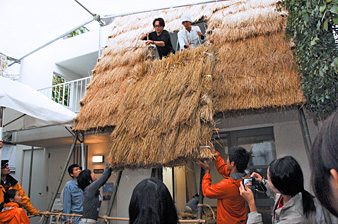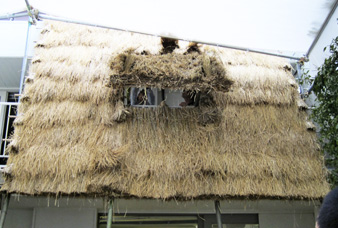"Let's Roof Thatch" Experience Class Report
Date and time: October 30, 2011 (Sun) 10:00-15:00
Venue: Takenaka Carpentry Tools Museum Annex Outdoor Parking
Instructor: Minoru Shiozawa (thatched roof), old folk house (Mukogawa Women's University)
Number of participants: 16 people
To commemorate the holding of the Kobe venue, a special exhibition "Roof made of grass and wood-", a thatched experience class was held. We welcomed Minoru Shiozawa, a thatch craftsman who is also in Speakers on October 16, and members of the old folk house family of Mukogawa Women's University, as Instructor.

The thatched roof that I will tell you this time is a technique of "Toma roofing" that was once used for crop huts. I will try to roof this tomatched roof on the veranda of the annex of the tool building instead of the roof of the house. It is a thatched roof that does not pass through and is rich in breathability and creates a pleasant shade of trees, but it is not very familiar to modern urban people. This time, it is a suggestion that you would like to incorporate thatched roofs close to the city.

This is a rope knot training course. "Master bond" taught at a hands-on class in Tokyo. That's the basis of thatched roof.

Knit small amount of rice straw into a panel shape. This is called "Toma knitting". The word Toma has a long history and is also written in Manyoshu. 'Autumn rice field Kariho no hermitage is wet with the dew' (Emperor Tenji)

Toma knitting is attached to a bamboo frame with a male knot. On the left is Mr. Shiozawa of Instructor.

It looks like raising the kaya panel made by everyone to the second floor. After that, the craftsman put it on the window.

It is the completion of a tomatched roof with a bay window on the veranda! Especially in the summer when the sun is strong, you can spend comfortably.

The back side of the tomatched roof has a structure in which the tomatched panels are arranged vertically and horizontally, and a bamboo frame is tied with a rope.

I was worried about the rain this day, but I managed to get it to the end. Thank you very much to everyone who participated and everyone at Instructor.
The tomatched roof that was completed on this day is displayed in front of an annex in Takenaka Carpentry Tools Museum during the "Roofing Exhibition". We would like to see many people, so please come and visit us.
